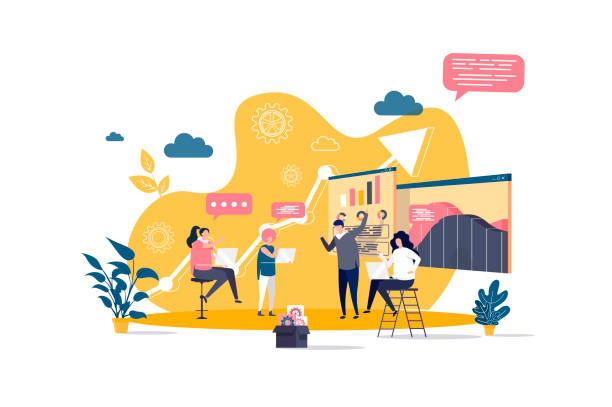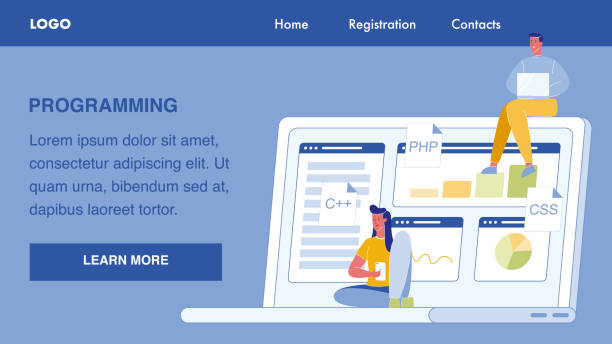The Importance of Globalization and the Need for Multilingual Websites

In today’s world, geographical boundaries have become meaningless in the digital space, and businesses need to reach global markets to expand their activities.
#Globalization and expanding access to international audiences is no longer an option, but an unavoidable necessity.
In this journey, your website is the main showcase of your business at an international level.
But how can you ensure that this showcase conveys your message in the best possible way, in different languages and considering various cultures? This is where the concept of multilingual website design shows its importance.
A multilingual website is a platform whose content is available to users in several languages, enabling businesses to communicate with their target audiences around the world in a language that is more tangible to them.
This approach not only strengthens your digital marketing but also builds user trust.
Creating a multilingual website goes beyond merely translating words; this process involves a deep understanding of cultural, regional, and even linguistic nuances that can play a vital role in attracting and retaining a global audience.
Without a clear strategy for multilingual content, businesses will miss countless opportunities in emerging and existing markets.
This explains the necessity of multilingual websites in the digital age.
Worried about losing customers because you don’t have a professional e-commerce site?
With e-commerce website design by Rasaweb, forget these worries!
✅ Significant increase in sales and visitor-to-customer conversion rate
✅ Professional and user-friendly design that builds customer trust
⚡ Get free consultation from Rasaweb
Unrivaled Competitive Advantages with Multilingual Website Design

Building a multilingual website is not just about adding a few languages to your website, but a powerful strategy for gaining a sustainable competitive advantage.
The first and most important advantage is a significant increase in audience reach.
By providing content in different languages, you can reach millions of new users who were previously unable to interact with your website due to language barriers.
This means increased website traffic and, ultimately, growth in your business potential.
Furthermore, a multilingual website significantly increases your business’s trust and credibility.
When users can find the information they need in their native language, they feel more comfortable and confident with your brand, which greatly helps improve conversion rates.
Research has shown that most users prefer to shop from websites whose content is provided in their own language.
In the field of international SEO, multilingual website design also plays a vital role.
Search engines rank websites that provide quality multilingual content better, which helps you prominently appear in search results for various keywords in multiple languages.
This is an analysis of the multifaceted benefits of multilingual websites, which go beyond mere translation and act as a strategic growth lever.
Key Considerations in Planning a Successful Multilingual Website Design

Before starting a multilingual website design project, meticulous planning and considering key factors are of utmost importance.
The first step is determining the target languages.
This choice should be based on the target market, growth potential, and existing analytical data about your current and future audience.
Do you want to focus only on widely used international languages like English, Spanish, and Chinese, or are you looking for more specific markets? After that, a deep understanding of cultural and regional differences is essential.
Localization goes beyond translating words; it involves adapting content, images, date and currency formats, and even website layout to the cultural expectations of the audience for each language.
For example, colors and symbols have different meanings in different cultures.
Legal issues and compliance with local laws, such as data privacy regulations (GDPR in Europe), must also be carefully considered to prevent legal problems.
Also, the necessary infrastructure for managing multilingual content must be considered; does your current CMS support multilingual capabilities, or do you need to upgrade or use auxiliary tools? Tutorial: The table below helps you identify common challenges and solutions in planning multilingual website design.
| Key Challenge | Proposed Solution |
|---|---|
| Selecting appropriate languages | Analyzing website traffic data and target market research |
| Content translation and localization | Using native translators and localization specialists |
| URL structure management | Choosing a subdomain, subdirectory, or different TLD domain |
| International SEO issues | Implementing hreflang tags and geotargeting |
| Updates and maintenance | Using a robust content management system and regular planning |
This section provides a comprehensive guide to understanding the initial complexities and cautious planning before starting your multilingual project.
Technical Aspects of Multilingual Website Design Implementation

Implementing a successful multilingual website design requires a deep understanding of its technical aspects.
Choosing the right URL structure is one of the first important decisions: will you use subdomains (e.g., en.example.com), subdirectories (e.g., example.com/en/), or different TLD domains (e.g., example.de)? Each of these structures has its own advantages and disadvantages in terms of SEO and management.
Subdirectories are generally a popular choice due to their ease of implementation and SEO management.
The use of hreflang tags is also a technical necessity.
These tags help search engines identify the correct version of a page based on the user’s language and geographical region, preventing duplicate content issues.
Proper hreflang implementation is complex and requires high accuracy.
Additionally, your CMS infrastructure must fully support multilingual capabilities.
Many modern CMSs such as WordPress (with plugins like WPML or Polylang), Drupal, and Joomla, offer powerful built-in tools or plugins for managing multilingual content.
Ensuring that your website can handle specific characters of each language (such as Cyrillic or Arabic letters) is very important, and appropriate encoding (e.g., UTF-8) should be considered from the outset.
This specialized section focuses on the technical aspects that form the foundation of a robust and efficient multilingual website.
Did you know that poor online store design can drive away up to 70% of your potential customers? Rasaweb revolutionizes your sales with professional and user-friendly e-commerce website designs.
✅ Significant increase in sales and revenue
✅ Full optimization for search engines and mobile
⚡ [Get free consultation from Rasaweb]
Search Engine Optimization (SEO) for Multilingual Websites

For a multilingual website design to be truly successful, international SEO principles must be carefully observed.
SEO for multilingual websites goes beyond traditional SEO and includes specific considerations.
Keyword research must be conducted separately for each language and geographical region.
Simply translating keywords is often ineffective, as search phrases and user intent differ across various cultures.
For example, a word that has a specific meaning in one language may not have a similar concept in another or be searched less frequently.
As mentioned in the technical section, correct implementation of hreflang tags is crucial for Google and other search engines to display the appropriate language version to users and prevent duplicate content penalties.
Geotargeting through tools like Google Search Console is also very important for multilingual websites, allowing you to inform search engines about your target markets.
Local optimization for each language version, building local links, and creating trust signals through local domains and hosting all contribute to improving your website’s SEO ranking in target markets.
This guide emphasizes the importance of a comprehensive and localized SEO strategy for global success.
Content Management and Translation Beyond Words

In the realm of multilingual website design, content management and the translation process extend far beyond merely converting words from one language to another.
What truly matters is localization; a process through which content is adapted to be fully aligned with the cultural, social, and even dialectal nuances of the target audience in each region.
The challenging content is how to ensure that the core message and brand tone are maintained across all languages, while being fully localized? This requires close collaboration with native translators and marketing specialists who have a deep understanding of the target market.
Content must not only be grammatically correct but also culturally appropriate and impactful.
For example, images, metaphors, and cultural references that are appealing in one country might be completely meaningless or even offensive in another.
Establishing a workflow for translated content management that includes review, editing, and approval stages is essential for maintaining quality and consistency.
Utilizing Translation Management Systems (TMS) and Translation Memories (TM) can help accelerate the process and maintain consistency.
This section demonstrates that success in multilingual content management requires a comprehensive approach that goes beyond superficial translation.
User Experience and User Interface in Multilingual Website Design

User Experience (UX) and User Interface (UI) are of particular importance in multilingual website design.
Designing an intuitive and user-friendly interface that allows for easy language switching is key.
The placement of the language switch button, usually at the top of the page or in the navigation menu, should be such that users can quickly and without confusion select their desired language.
Furthermore, attention must be paid to layout compatibility with different languages.
For example, right-to-left languages (such as Persian and Arabic) require a complete change in the orientation of page elements.
Content readability across various fonts and sizes must also be tested, as some fonts are more suitable for specific languages.
Page loading speed should also be optimized across all language versions so that users anywhere in the world have a smooth and fast experience.
In this news section, we introduce important features that modern multilingual websites should have to provide an excellent user experience.
| UX/UI Element | Description and Best Practice |
|---|---|
| Language switcher | Visible and easily accessible (usually in the header or footer), using full language names or recognized flags. |
| Page orientation (RTL/LTR) | Full support for right-to-left and left-to-right languages without design disruption. |
| Text space and design | Allowing sufficient space for texts that may become longer or shorter after translation. |
| Fonts and typography | Selecting fonts that support characters of all target languages and have high readability. |
| Images and videos | Using global or localized visual content appropriate for different cultures. |
By considering these points, the user experience for your international visitors will significantly improve, leading to their satisfaction.
Popular Tools and Platforms for Multilingual Website Design

Choosing the right tools and platforms is a vital step in the multilingual website design process.
Fortunately, many Content Management Systems (CMS) with multilingual capabilities exist today that facilitate this process.
WordPress, as the world’s most popular CMS, easily provides the ability to create and manage multilingual content using plugins like WPML (WordPress Multilingual Plugin) and Polylang.
These plugins allow you to create and easily manage different versions of pages and posts for each language.
Drupal and Joomla are also powerful CMSs that offer built-in multilingual capabilities or comprehensive plugins for this purpose and are suitable for larger and more complex projects.
In addition to CMSs, Translation Management Systems (TMS) such as Smartling, MemoQ, and Trados Studio can be very useful in managing large volumes of translation and maintaining terminology consistency.
These tools facilitate collaboration between translation teams, the use of translation memories, and terminology glossaries, which adds to the speed and quality of translation.
Choosing the right platform depends on your project’s specific needs, budget, and your team’s technical expertise, but fortunately, there are many efficient options available for any scenario.
Are you dissatisfied with the low conversion rate of visitors to customers on your e-commerce site?
With professional e-commerce website design by Rasaweb, solve this problem forever!
✅ Increase visitor-to-customer conversion rate
✅ Create an excellent user experience and build customer trust
⚡ Get free consultation
Continuous Maintenance and Updates of a Multilingual Website

A multilingual website design project does not end with its launch; rather, it requires continuous maintenance and updates.
Content across all language versions must be regularly reviewed and updated to ensure its accuracy and relevance.
This includes updating news, blog articles, product and service information, and any other dynamic content.
Compliance with local and international laws, such as data privacy regulations, is an ongoing process that must be continuously monitored.
This section explains the importance of regular maintenance.
Monitoring website performance across all languages and geographical regions is also very important.
Is loading speed optimized in all countries? Do users face any specific issues? Using web analytics tools to track traffic, user behavior, and conversion rates for each language helps you identify strengths and weaknesses and implement necessary improvements.
Furthermore, the security of a multilingual website must be continuously monitored, as each language version can create potential vulnerabilities for cyberattacks.
A comprehensive maintenance plan ensures that your multilingual website remains efficient, secure, and at peak performance, helping your business achieve its goals.
The Future of Multilingual Website Design and Emerging Trends

The future of multilingual website design looks exciting with technological advancements, especially in the field of artificial intelligence.
Artificial Intelligence (AI) and Machine Learning (ML) are transforming translation and localization processes.
Neural Machine Translation (NMT) tools are becoming increasingly accurate and natural, and while they cannot yet fully replace human translators, they significantly boost speed and efficiency.
This is an analysis of future trends.
Another emerging trend is multilingual content personalization.
Using user data and AI, websites will be able to offer content and experiences specifically optimized for each user, considering their language, region, interests, and even purchase history.
This level of personalization significantly increases user engagement and loyalty.
The rise of voice search and voice assistants also poses a new challenge for multilingual websites.
Optimizing content to respond to voice queries in different languages requires new approaches to keyword research and content structure.
Given the ever-expanding global markets and the increasing demand for access to information in native languages, multilingual website design is not just a current necessity, but a strategic investment for the digital future of businesses.
These trends indicate that multilingual websites are moving towards more interactive, intelligent, and personalized experiences.
Frequently Asked Questions
| Question | Answer |
|---|---|
| What is multilingual website design? | It is the design of a website whose content is available to users in several different languages, allowing users to choose their preferred language. |
| Why is a multilingual site important? | To access international audiences, increase website traffic, improve user experience for non-Persian speaking visitors, and expand business in global markets. |
| What are the benefits of having a multilingual site? | Increased international SEO, attracting new customers from different countries, enhancing business credibility and professionalism, and reducing bounce rate by providing understandable content. |
| What are the methods for implementing a multilingual site? | Using subdirectories (e.g., example.com/en/), subdomains (e.g., en.example.com), or separate top-level domains for each language (e.g., example.com and example.de). |
| Which URL structure is best for international SEO? | Subdirectories (e.g., example.com/en/) are often preferred for SEO due to the consolidation of main domain authority, although each method has its advantages and disadvantages. |
| How does a multilingual site affect SEO? | By providing content in different languages, the site appears in local search results for those languages, click-through rate and traffic increase, and overall domain authority improves. Correct use of hreflang tags is crucial. |
| How is content translation managed? | One can use professional translators, machine translation tools (with human editing), or Content Management Systems (CMS) with built-in multilingual capabilities or relevant plugins. |
| What are common challenges in multilingual website design? | Managing translated content, maintaining design consistency across different languages, compatibility with Right-to-Left (RTL) languages like Persian and Arabic, SEO optimization for each language, and selecting the appropriate URL structure. |
| How do I manage text direction (LTR/RTL) on a multilingual site? | For Right-to-Left languages (like Persian), you need to apply specific CSS styles to change text direction, element layout, and table direction. Often by using the property direction: rtl; and other related settings. |
| How can users change the site’s language? | Usually by using a button, dropdown menu, or language selector widget clearly placed in the site’s header or footer. Automatic detection of the user’s browser language and suggesting a language change is also common. |
And other advertising services by Rasaweb Advertising Agency
- Smart Digital Advertising: An innovative service for increasing customer acquisition through attractive user interface design.
- Smart Custom Software: Revolutionize customer behavior analysis with the help of Google Ads management.
- Smart Link Building: A combination of creativity and technology to attract customers through custom programming.
- Smart Direct Marketing: A combination of creativity and technology for user engagement through SEO-driven content strategy.
- Smart Digital Branding: Revolutionize campaign management with the help of key page optimization.
And over hundreds of other services in internet advertising, advertising consultation, and organizational solutions
Internet Advertising | Advertising Strategy | Advertorials
Sources
Benefits of Multilingual Website Design for International Businesses
Complete Guide to Multilingual Website Design
Increase International Sales with a Multilingual Site
How to Optimize Your Website for Global Audiences
? For your business to soar in the digital world and achieve unprecedented success, Rasaweb Afarin Digital Marketing Agency is by your side with its expertise and experience. From user-friendly website design and SEO optimization to executing targeted advertising campaigns, we are ready to transform your brand in the online space and pave the way for sustainable growth.
For consultation and to receive services, contact us.
📍 Tehran, Mirdamad Street, next to the Central Bank, South Kazerun Alley, Ramin Alley, No. 6

